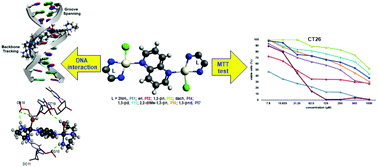Synthesis, cytotoxic activity and DNA interaction studies of new dinuclear platinum(ii) complexes with an aromatic 1,5-naphthyridine bridging ligand: DNA binding mode of polynuclear platinum(ii) complexes in relation to the complex structure†
Abstract
The synthesis, spectroscopic characterization, cytotoxic activity and DNA binding evaluation of seven new dinuclear platinum(II) complexes Pt1–Pt7, with the general formula [{Pt(L)Cl}2(μ-1,5-nphe)](ClO4)2 (1,5-nphe is 1,5-naphthyridine; while L is two ammines (Pt1) or one bidentate coordinated diamine: ethylenediamine (Pt2), (±)-1,2-propylenediamine (Pt3), trans-(±)-1,2-diaminocyclohexane (Pt4), 1,3-propylenediamine (Pt5), 2,2-dimethyl-1,3-propylenediamine (Pt6), and 1,3-pentanediamine (Pt7)), were reported. In vitro cytotoxic activity of these complexes was evaluated against three tumor cell lines, murine colon carcinoma (CT26), murine mammary carcinoma (4T1) and murine lung cancer (LLC1) and two normal cell lines, murine mesenchymal stem cells (MSC) and human fibroblast (MRC-5) cells. The results of the MTT assay indicate that all investigated complexes have almost no cytotoxic effects on 4T1 and very low cytotoxicity toward LLC1 cell lines. In contrast to the effects on LLC1 and 4T1 cells, complexes Pt1 and Pt2 had significant cytotoxic activity toward CT26 cells. Complex Pt1 had a much lower IC50 value for activity on CT26 cells compared with cisplatin. In comparison with cisplatin, all dinuclear Pt1–Pt7 complexes showed lower cytotoxicity toward normal MSC and MRC-5 cells. In order to measure the amount of platinum(II) complexes taken up by the cells, we quantified the cellular platinum content using inductively coupled plasma mass spectrometry (ICP-QMS). Molecular docking studies performed to evaluate the potential binding mode of dinuclear platinum(II) complexes Pt1–Pt7 and their aqua derivatives W1–W7, respectively, at the double stranded DNA showed that groove spanning and backbone tracking are the most stable binding modes.



 Please wait while we load your content...
Please wait while we load your content...